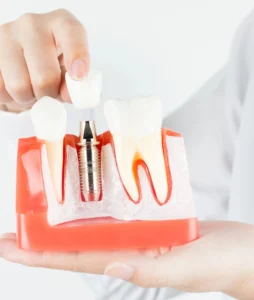Did you know that one in three Americans say that when meeting someone new, the first feature they note is their smile? For decades since dental braces were discovered, people have been looking towards these orthodontic tools to achieve a perfect smile.
There are many different varieties of braces, including lingual braces. The appearance of the many forms of braces varies, as do their working times and pros and cons. Lingual braces are one of the types that have grown in popularity in recent years.
So if you are interested in learning about lingual braces, keep reading to find out what the best Dentists West Hills has to say.
What Are Lingual Braces?
The invention of lingual braces took place in the US, dating back to 1975. The masterminds behind lingual braces are Jim Mulick and Craven Kurzwere.
The first client Kurz treated with lingual braces was a Playboy member, and when given the choice of traditional braces, she preferred to receive braces that concealed the metal and did not show when she smiled. She insisted, and Craven responded by creating the first-ever lingual braces.
Lingual braces are described as dental braces performing the same function as conventional braces, but the difference is that they are positioned behind your teeth instead of in front. People who wish to get their teeth aligned without the braces being visible when they smile can choose lingual braces as it is the ideal aesthetic option.
How Long Does It Take For Lingual Braces To Work?
According to the best Dental Clinic Near Woodlands, there is no simple answer to how long lingual braces may take to work since this answer may vary from patient to patient. Each patient’s demands and the quantity of dental work required will determine long they will have to wear lingual braces to get proper results.
The average person must wear lingual braces for anywhere from one to two years until they reach the desired outcomes. In extreme cases, when the teeth may be excessively crooked, it may take an additional year for the intended results to show.
How long lingual braces take to work also depends on your age since lingual braces may take one to two years to show proper results if you are an adult. However, it may take longer if the person having the braces is a child. The jaw continues to grow at 12 to 13 years, so the child’s teeth can shift easily.
Another factor determining how long lingual braces will take to work for you is the amount of care you take to ensure your lingual braces work properly.
If you are someone who doesn’t follow their dentist’s instructions, regularly breaks brackets refuses to wear rubbers, and misses dental appointments to get the wires tightened, it may take longer for lingual braces to work for you.
Heading to the dentist and getting a consultation for lingual braces is the best way to determine how long you can expect lingual braces to work for you.
How Should Lingual Braces Be Cared For To Ensure They Work Quickly?
- Brush at least twice a day:Regular brushing can help ensure no food is stuck within your braces since food buildup can increase the chances of brackets breaking. Doing so will also help you avoid plaque buildup on the braces and keep your pearly whites clean and shiny
- Utilize oral irrigators:Oral irrigators are a must-have if you have lingual braces since they can help you easily clean your teeth without risking damage to the braces. Getting some spots on your teeth with floss or a toothbrush may be challenging if you have braces. Oral irrigators combined with regular brushing can help you maintain optimal oral health and get rid of the food particles that may be lodged within your brackets without putting the brackets at risk of breaking
- Floss once a day:People with braces may find it challenging to eliminate the food buildup from their teeth from brushing. This is where floss comes in, as it can help you clean the areas of your teeth where the toothbrush might not be able to reach
- Go to regular dental checkups:Lingual braces require proper cleaning and maintenance from the dentist to ensure they work properly. Therefore, visiting the dentist at least every six months can help you maintain clean lingual braces, get rid of tartar buildup, and ensure that they are working optimally
- Consider using a fluoride rinse: A fluoride rinse can help your teeth stay strong since when you rinse your teeth with fluoride, the fluoride allows the dissolved minerals to return toward the enamel surface to develop a new, stronger acid-resistant tooth structure.
Are Lingual Braces The Best Option For You?
Here are a few factors that may help you determine if lingual braces are the right choice of braces for you:
- You want concealed braces that do not show when you smile
- You play contact sports, and lingual braces are a safer and more risk-free option for you
- You desire straight teeth and a braces option that does not compromise your professional appearance
- You are a musician and play an instrument that makes it impossible for you to get traditional braces
- You desire a braces solution that may cause less discomfort than conventional braces
Contact Dental Care West Hills to Become One Step Closer To Perfectly Aligned Teeth
Now that you know everything there is to know about lingual braces, all there’s left to do is contact a reliable dentist to begin your journey of getting aligned teeth.
If you live in the woodland hills area and are looking for a trustworthy woodland hills dentist, Dr. Mike Salekian is waiting for you at the West Hills Smiles clinic. We offer various dental services, from smile makeovers to dental implants and General Dentistry Services Calabasas. So what are you waiting for? Book an appointment now.
If you have further queries on our services, feel free to call us at (818) 346-4303.



